Class Takeaways — The Industrialist’s Dilemma
Five lessons in five minutes: lecturer Robert E. Siegel teaches you how to survive disruption.
May 04, 2021
How are startups challenging the status quo? What can big companies do to survive? In his class The Industrialist’s Dilemma, Stanford GSB lecturer in management Robert E. Siegel shares five important takeaways for organizations seeking to weather the disruptions of the digital economy.
Full Transcript: The Industrialist’s Dilemma
Hi, I’m Rob Siegel, lecturer in management at Stanford Graduate School of Business. I teach six different courses at Stanford GSB, but today we’re going to talk about the key takeaways from one of them, The Industrialist’s Dilemma.
1. Consider Both Digital and Physical
What’s different about The Industrialist’s Dilemma is that the combination of physical and digital is completely different than anything that’s happened before. And it’s increasing the speed with which markets are able to change. And it also enables new companies to come into markets that previously would not have been able to. And you can study every industry to see how the combination of hardware and software, digital and physical are being impacted by these technological and business model changes. One of the things we’ve learned in studying the industrialist’s dilemma is that neither incumbents nor disruptors are necessarily preordained to win in the market. Disruptors have a blank sheet of paper. They can think with a clean slate about how they’re going to meet customer needs, but they often don’t have the domain knowledge of what it takes to be successful in a particular market. Incumbents often have deep balance sheets, but they need to move more quickly and build skillsets and competencies that maybe they haven’t had previously in their organization.
2. Connect with Customers
In a world where every product is connected, companies need to keep in mind two things. Number one, they need to develop the capabilities to write the software to communicate with the customers, and then how to manage it on an ongoing basis, to listen to the conversations with customers, to understand how customers are using the products, and to think about how they can constantly be improving their products to delight customers and thinking about customer outcomes. At the same time, organizations need to understand that the entire ecosystem might be jealous of that ongoing conversation and relationship between maybe a company that manufactures something and the end user, and people in a channel might want to be a part of that data stream going back and forth.
3. Turn Headwinds into Tailwinds
In a world where digital and physical are combining to create massive disruption across industries, somebody is going to end up being the underdog and somebody’s going to be on their heels. Being an underdog can actually be very liberating. In some ways, when you’re on your heels, you have nothing to lose and you have a license to try new things and be very creative. You can look at ways in which headwinds can actually become tailwinds that can actually propel you forward. So a change in technology, a change in an industry could actually be an opportunity for a company to catapult itself to do business in a new way. An example of a company that turned a headwind into a tailwind is the North American electronics retailer, Best Buy. Eight years ago, their product was being commoditized. Everybody was buying televisions and telephones online and just trying to get the lowest price. But as all of these products became increasingly connected to the internet, their level of complexity went up. What Best Buy figured out is they could be the best service retailer, not just selling the box themselves, but making sure the customers knew how to connect them to the networks and to each other, to deliver a better customer experience.
4. Innovate on Tech and Business Models
Companies that innovate on both new technologies and new business models end up becoming the winners long-term. A great example is Align Technologies, the people who make the clear Invisalign teeth straightening tool. The technology behind the clear plastic aligners was very, very difficult. It is very difficult to manufacture, but what they did really well is they also increased their channels selling not only through orthodontists, but through dentists, which very much expanded the market. And allowed adults to start using the product and not just teenagers. What we found is that having business model innovation and technological innovation was a real force multiplier. And doing only one of these was necessary, but not sufficient for long-term success.
5. Learn to Work with Governments
As companies from the technology industry move into things like health care and financial services, they start getting into areas where governments increasingly regulate these areas. In addition, it starts to get to national industrial policy. Leaders of companies for the next several decades are going to have to be very conversant in how to work with and collaborate with governments all over the world and know how to be successful in a world that’s increasingly complex.
For media inquiries, visit the Newsroom.
Explore More

So Crazy, It Might Just Work: How Foolishness Feeds Innovation

Zoom In... or Out? Why Face-to-Face Meetings Matter



